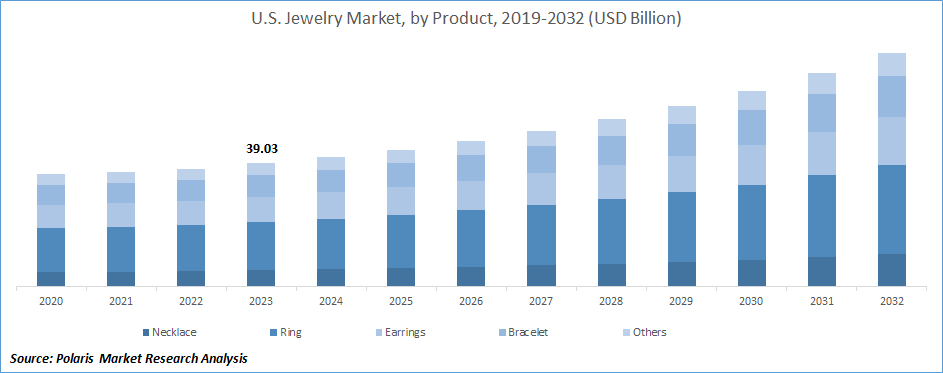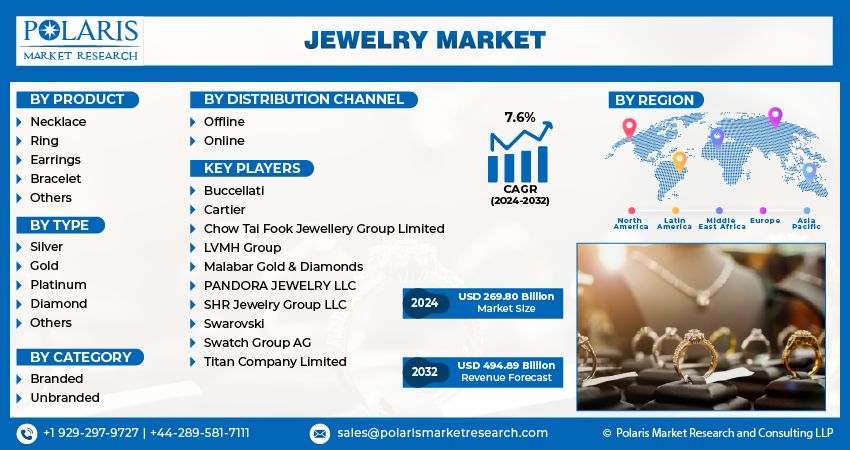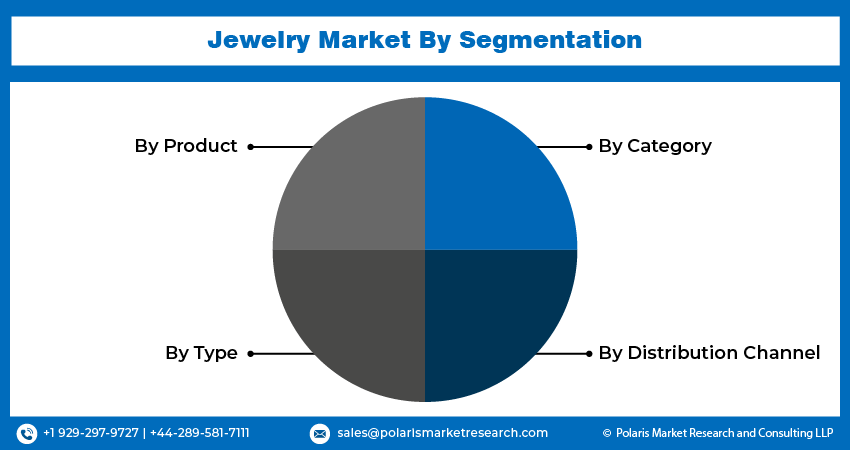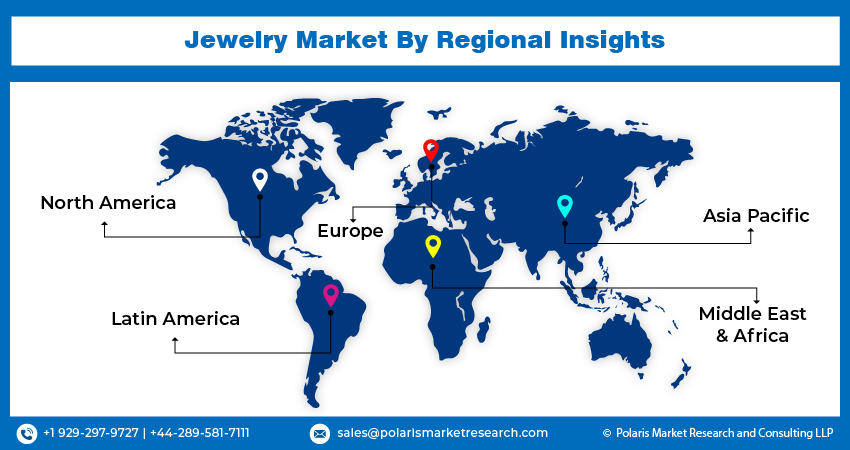
Jewelry Market Share, Size, Trends, Industry Analysis Report, By Product (Necklace, Ring, Earrings, Bracelet, Others); By Type; By Category; By Distribution Channel; By Region; Segment Forecast, 2024 - 2032
- Published Date:Jun-2024
- Pages: 119
- Format: PDF
- Report ID: PM2284
- Base Year: 2023
- Historical Data: 2019-2022
Report Outlook
Jewelry market size was valued at USD 256.81 billion in 2023. The market is anticipated to grow from USD 269.80 billion in 2024 to USD 494.89 billion by 2032, exhibiting the CAGR of 7.6% during the forecast period.
Industry Trends
The jewelry market is expected to experience significant growth during the forecast period due to several key factors. These include acquisitions and strategic collaborations among major industry players, a rising trend for cross-cultural jewelry, and the increasing use of e-commerce for jewelry purchases.

To Understand More About this Research:Request a Free Sample Report
The jewelry market's growth is further propelled by the increasing trend of cross-cultural ornaments. This is facilitated by the allocation of larger advertising budgets and the launch of new international campaigns, enabling a diverse range of products to be distributed globally. Notably, the role of e-commerce in boosting industry sales cannot be overstated, as it reflects the changing consumer behavior and preferences.
Furthermore, the development of the jewelry market in emerging countries and the establishment of new branches by industry players are contributing to regional growth.
For instance, in December 2021, PMJ Jewels inaugurated its inaugural store in Kompally, North Hyderabad, as part of an ambitious planned expansion. The store showcases a wide array of diamonds, gold, and solitaire designs, including high-end diamond bridal accessories.
The jewelry market, with its timeless allure and enduring appeal, has long been influenced by various socio-economic factors. Among these factors, the rising disposable income of consumers stands out as a potent driver that has continuously shaped the industry's landscape. Over the years, the correlation between increasing disposable income and the demand for jewelry has been evident, influencing the market's growth, trends, and consumer preferences. As disposable income levels rise, consumers often experience an enhanced sense of financial security and well-being. This increased financial stability frequently translates into greater spending power, allowing individuals to allocate more of their resources to discretionary purchases, such as jewelry. The jewelry market benefits significantly from this trend, as consumers are more inclined to invest in high-quality pieces, marking special occasions and expressing their personal style.
Key Takeaways
- Asia Pacific dominated the market and contributed over 50% share of the jewelry market in 2023
- By product category, necklace segment dominated the global jewelry market size in 2023
- By type category, the gold segment is anticipated to grow with a significant CAGR over the jewelry market forecast period
What are the Market Drivers Driving the Demand for Market?
Consumer Preference for Personalization in the Jewelry Market
The jewelry market has undergone a remarkable evolution in recent years, and one of the pivotal drivers that has left an indelible mark on the industry is the consumer preference for personalization. This powerful trend, which has continued to gain momentum, has not only redefined the way individuals perceive and acquire jewelry but has also prompted jewelers and designers to rethink their approach to meeting the evolving demands of their clientele. The shift towards personalization in the jewelry market was not just a passing fad but a profound transformation that touched every aspect of the industry. Consumers, in the quest for uniqueness and self-expression, started gravitating away from mass-produced, one-size-fits-all jewelry designs that had dominated the market for generations. Instead, they sought pieces that would resonate with their personalities, stories, and emotions. This marked the beginning of a significant shift in consumer behavior and preferences.
The essence of this personalization movement was the idea that jewelry should be a reflection of an individual's identity, a tangible representation of their uniqueness. As a result, customization became the new norm. Jewelry buyers began to cherish the ability to tailor their pieces, right from selecting the type of metal to designing intricate motifs or adding personalized engravings. This shift towards individuality enabled consumers to craft jewelry that told their own stories, celebrated personal milestones, or honored their cultural heritage.
Which Factor is Restraining the Demand for the Market?
Fluctuating Raw Material Prices
In the jewelry market, the fluctuation of raw material prices, particularly precious metals, has long presented a significant restraint that industry players must contend with. The prices of these essential materials are known for their volatility, which can create several challenges for jewelry manufacturers, designers, and retailers, impacting everything from production costs to consumer affordability. This enduring restraint has prompted the industry to develop strategies and adaptations to mitigate the effects of fluctuating raw material prices. One of the most prominent raw materials in the jewelry market is gold. Renowned for its timeless appeal and durability, gold has remained a preferred choice for crafting jewelry for centuries. However, the price of gold is inherently tied to a myriad of global economic factors, including inflation, currency fluctuations, geopolitical events, and investor sentiment. As a result, the price of gold can experience sharp and unpredictable fluctuations, creating uncertainty in the jewelry industry.
When raw material prices, particularly gold, experience significant increases, the jewelry market faces a series of pressing challenges. Foremost among these challenges is the impact on production costs. Precious metals often constitute a substantial portion of the cost of jewelry production, and when their prices soar, manufacturers and designers must grapple with higher expenses. This often leaves them with a difficult decision: whether to absorb the increased costs, which can squeeze profit margins, or pass them on to consumers, potentially dampening demand for jewelry.

Report Segmentation
The market is primarily segmented based on product, type, category, distribution channel, and region.
|
By Product |
By Type |
By Category |
By Distribution Channel |
By Region |
|
|
|
|
|
To Understand the Scope of this Report:Speak to Analyst
Category Wise Insights
By Product Insights
Based on product category analysis, the market has been segmented on the basis of necklace, ring, earrings, bracelet, and others. Necklace segment dominated the jewelry market in 2023 since necklaces are highly versatile accessories that complement a wide range of outfits, making them popular across different demographics and occasions. They are often considered statement pieces, providing a focal point in fashion ensembles, which enhances their appeal.
Moreover, necklaces are frequently gifted for special events such as weddings, anniversaries, and holidays, driving consistent demand. The variety available, from simple pendants to elaborate designs, caters to diverse tastes and budgets, further broadening their market reach. Additionally, cultural and traditional significance in many regions, where necklaces hold symbolic value, contributes to their sustained popularity and market share dominance.
By Type Insights
Based on type category analysis, the market has been segmented on the basis of silver, gold, platinum, diamond, others. The gold segment's dominance in the global jewelry market and its projected significant CAGR is due to its durability, malleability, and lustrous appearance, making it a preferred material for crafting jewelry. Its intrinsic value as a precious metal also makes gold jewelry an attractive investment, offering both aesthetic appeal and financial security. Cultural and traditional factors play a substantial role, especially in regions like India and China, where gold jewelry is deeply embedded in social customs and rituals. The rising disposable income and increasing demand for luxury goods in emerging markets further bolster this trend. Moreover, the continued innovation in design and craftsmanship, coupled with effective marketing strategies, enhances gold jewelry's desirability. These factors collectively drive the robust growth and sustained dominance of the gold segment in the jewelry market.

Regional Insights
Asia Pacific
The Asia Pacific region dominated the jewelry market in 2023, primarily driven by robust demand from China and India, where gold holds significant cultural and economic value. For instance, India witnessed a 37% year-on-year surge in gold consumption, reaching 140 tonnes in the first quarter of 2021. This coincided with a decrease in Covid-19 cases, leading to increased consumer spending. Gold ornaments are particularly favored for their association with weddings and festivities, contributing to their sustained high demand in the market.

Competitive Landscape
The market is characterized by the presence of key players such as Chow Tai Fook Jewellery Group Limited, LVMH Group, PANDORA JEWELRY LLC, Cartier, Titan Company Limited, and Swatch Group AG. It is highly competitive, driving players to pursue strategies such as acquisitions, launches, collaborations, and partnerships. Additionally, there is a focus on developing new products with enhanced speed and features to strengthen product portfolios and maintain a competitive edge in the market.
Some of the major players operating in the global market include:
- Buccellati
- Cartier
- Chow Tai Fook Jewellery Group Limited
- LVMH Group
- Malabar Gold & Diamonds
- PANDORA JEWELRY LLC
- SHR Jewelry Group LLC
- Swarovski
- Swatch Group AG
- Titan Company Limited
Recent Developments
- In September 2023, Swarovski Created Diamonds launched the 'Galaxy' collection, an exquisite line inspired by cosmic phenomena and designed by Global Creative Director Giovanna Engelbert, launched collections in the US and Canada.
- In August 2023, Buccellati launched a special edition of its famous bangles that are inspired by the abundance of colours, scents and flavours the Italian island of Capri has to offer.
- In June 2023, Tanishq Jewelry launched its updated 'Tanishq Gold Exchange Offer/Policy 2023,' offering exceptional value amidst fluctuating gold prices and marking the exchange of 100,000kg of gold in appreciation of 2 billion loyal customers.
- In September 2023, Titan Company, a part of the Tata Group, intends to launch nine additional Tanishq jewelry stores in Gujarat, aiming to reach a total of 28 outlets in the state by the end of this fiscal year while also considering international expansion in the United States and Australia.
Report Coverage
The jewelry market report emphasizes on key regions across the globe to provide better understanding of the category to the users. Also, the report provides market insights into recent developments, trends and analyzes the technologies that are gaining traction around the globe. Furthermore, the report covers in-depth qualitative analysis pertaining to various paradigm shifts associated with the transformation of these solutions.
The report provides detailed analysis of the market while focusing on various key aspects such as competitive analysis, product, type, category, distribution channel, and their futuristic growth opportunities.
Jewelry Market Report Scope
|
Report Attributes |
Details |
|
Market size value in 2024 |
USD 269.80 billion |
|
Revenue forecast in 2032 |
USD 494.89 billion |
|
CAGR |
7.6% from 2024 – 2032 |
|
Base year |
2023 |
|
Historical data |
2020 – 2022 |
|
Forecast period |
2024 – 2032 |
|
Quantitative units |
Revenue in USD billion and CAGR from 2024 to 2032 |
|
Segments covered |
By Product, By Type, By Category, By Distribution Channel, By Region |
|
Regional scope |
North America, Europe, Asia Pacific, Latin America, Middle East & Africa |
|
Customization |
Report customization as per your requirements with respect to countries, region and segmentation. |
FAQ's
Jewelry Market Size Worth USD 494.89 Billion by 2032.
The top market players in Jewelry Market are Chow Tai Fook Jewellery Group Limited, Buccellati, Cartier
Asia Pacific is the region contribute notably towards the Jewelry Market
Jewelry market exhibiting the CAGR of 7.6% during the forecast period.
Jewelry Market report covering key segments are product, type, category, distribution channel, and region.
